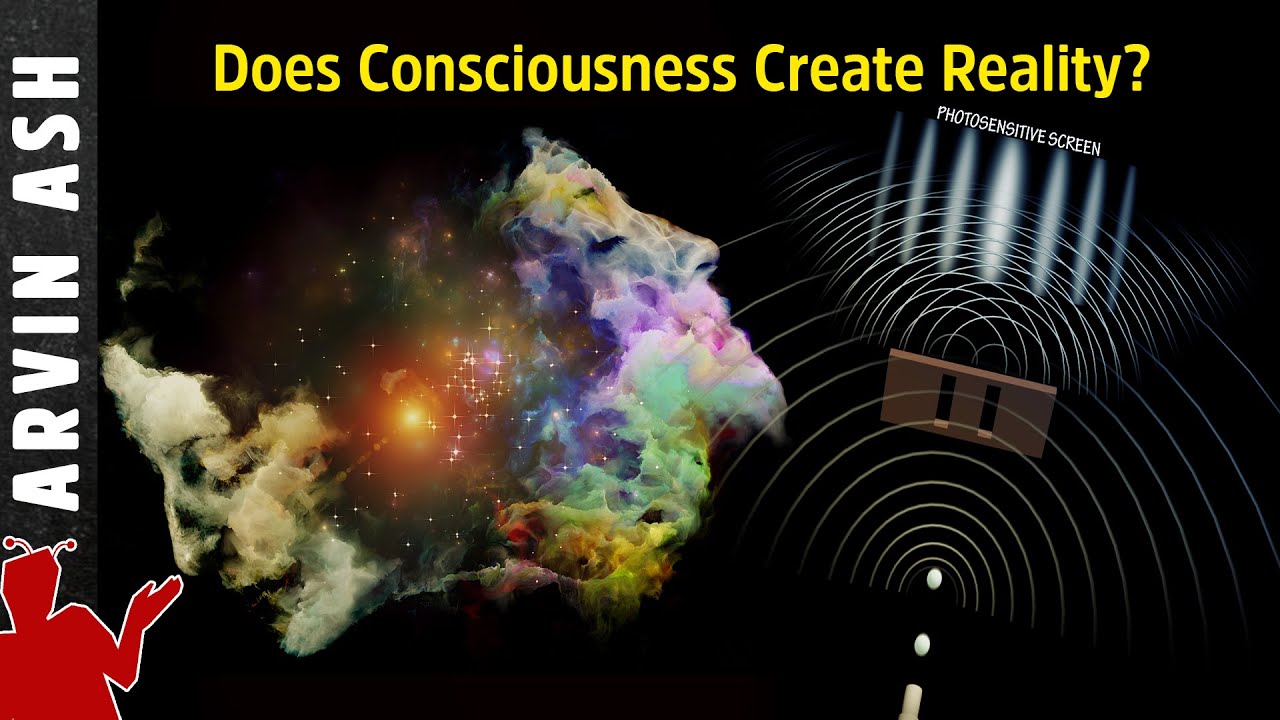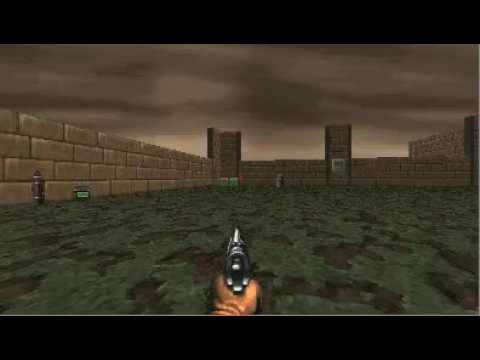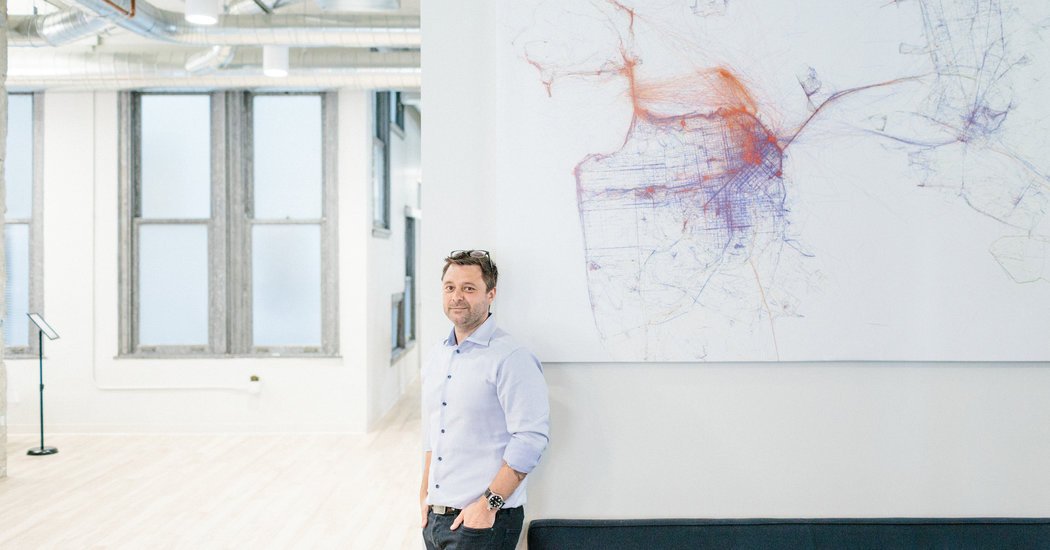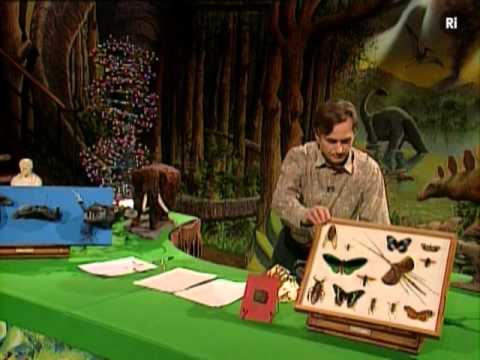Arvin Ash
The double slit experiment – Does consciousness create reality? Quantum mechanics shows us that particles are in superposition, meaning they can exist in different states and even multiple places at the same time. They are nothing more than waves of probabilities, until the moment that they are measured. One interpretation of this phenomenon is that the measurement being made requires a measurer, or a conscious observer. If this is correct, then it implies that consciousness has to be is an integral part of creating the world that we observe. Could this consciousness then be required for creating reality? Does this mean that there would be no reality without consciousness?
Experiments can show that what we think of as particles behave like waves. Waves of probabilities. This is the foundation of Quantum mechanics. The famous double slit experiment illustrates this. What is bizarre is that when you try to find out what’s going on at the slits by placing a detector at the two slits to try to figure out which slit the individual atoms are going through – the “WHICH WAY” information, they all of a sudden stop behaving like waves, and behave like particles.
Why do atoms and other particles behave this way? There are many interpretations of this phenomenon.
The most widely accepted interpretation, called the Copenhagen interpretation, was devised in 1925 by Neils Bohr and Werner Heisenberg at the University of Copenhagen. Their theory proposed that the atom when it is not measured, is not distinct. But the Copenhagen interpretation does not say anything about consciousness. But what is measurement after all?
Does measurement take place at the instrument that measures it? Does measurement necessarily require a consciousness? This is called the “measurement problem of quantum mechanics.” Physicists do not universally agree on a resolution. There are various interpretations.
One such interpretation is called the von Neumann–Wigner interpretation. This says that in the long chain of measurement, the collapse occurs at the moment that a consciousness interprets the measurement. The consciousness of the physicist is making the particle distinct. And without this consciousness, the atom would just be a wave of probabilities.
One fascinating interpretation is the many worlds interpretation. It was put forth by Hugh Everett in 1957. This theory postulates that there is NEVER any collapse, that we may be a measuring it in our reality, but there is no measurement happening in a different reality, and the wave function continues in that different branch of reality. But at some branch of reality, the particle collapse never actually happens. There is some new evidence that seems to support this idea of multiple realities. A paper published just this year in 2019 by Massimiliano Proietti at Heriot-Watt University in Edinburgh Seems to support the idea that at least two equally provable realities could exist at a quantum level at the same time.
So what is the correct answer? First let’s summarize what we know for sure – we know that measurement that records the which-way information of a particle indeed collapses a particle’s uncertainty wave. This particle collapse is consistent forward or backward in time as well, as shown by the delayed choice quantum eraser experiment.
As for many worlds, the equation allow it to be true, but since the other worlds appear to be inaccessible to us, there is no way to prove it. So just because it could be true, doesn’t mean it is true.
The Copenhagen interpretation is the most widely accepted, and in my view likely correct. It does not require a consciousness to interpret or even observe the results. I think the problem is with the word “observation” – which for many people seems to imply that someone has to look with their eyes. And eyes have a consciousness behind them.
But in quantum mechanics, this is not what the word observation means. So this unfortunate terminology of “observation” is what causes the confusion. In quantum mechanics an observation simply means the interaction of two quantum states that can collapse each other’s probability wave function. Does consciousness play a role. Probably not. And there is some new evidence that seems to show this.
A paper published by Shan Yu and Danko Nikolic in 2011 showed that a conscious observer was not necessary for the collapse. Their experiments measured the which-way information of a particle, but recorded it in the state of an atom. This information was not available to a conscious observer, but was preserved in the atom, in other words, it was available to the universe. Conclusion in video…
Citations:
Two realities: https://www.technologyreview.com/s/613092/a-quantum-experiment-suggests-theres-no-such-thing-as-objective-reality/
Delayed choice quantum eraser: https://en.wikipedia.org/wiki/Delayed-choice_quantum_eraser
Yu and Nikolic: tiny.cc/chw44y
#consciousness #doubleslit
Source




It's a glitch in the matrix
With any passage of time a whole new universe is created, and the old universe never existed.
Thanks for keeping it reasonably understandable. 👍👍
and why do you think an atom does not possess a consciousness of its own?
What does recorded in a state of atom mean?
Now, why is the screen not an observer and the particle detector is? Observing (looking at) the screen is "after the fact" , detector is "before the fact" . So there is an element of time-space???? Element of who/what is watching and where and when??? Must there be only ONE observer – screen only or detector only? Detector will mess with the screen. Without the screen, we will not know. Somehow the probabilities of the outcome are changing so that we would have to wait a really-really long time for the interference to show when the detector is "looking"? But wait, there is more…
The observations does not break down the wave it is only looking at and follows along a specific stored part and time of the waves quanta, the same way when we look at the waveform of quantizised digital stored audio as an example.
How does this comment address the issue of the observer "In quantum mechanics an observation simply means the interaction of two quantum states that can collapse each other’s probability wave function"? The observer with consciousness is that other quantum state that interacts with the particles and collapses the wave function. if we go by your "lack" of definition of the observer, what quantum state collapses the wave function? Also to take that a step further, didn't a human consciousness build the detector, perform the experiment, measure the data, wasn't the intent of the human consciousness plus measurable results that ultimately collapsed the wave function? When one says consciousness plays a role in how quantum world behaves, it is not the mind or the thinking consciousness; in fact it is one's conscious awareness of the measured, irrefutable data and results that leads quantum behavior to take its final form.
Best explanation Sir
Keep making physics so interesting 😊
Love from India ❤️
I would have made a great physicist … if it weren’t for all that math ! 🤣 I really appreciate your ability to explain complex topics in very understandable language
Arvin need one video on how you able to explain most complex concepts in most simplest way with complete depth of knowledge
It's just angles. No need for hokus pokus. The measurement device has to use a particle itself to measure the other particle. When they interact, certain angles are subtracted, and the resulting wave distribution changes.
Guys don't listen to people that don't have real studies on the subject. It's just like a child playing doctor.
The (delayed choice, quantum eraser) double slit experiment proves physical observation is physical interaction with the observed object, nothing more… Sci-woo is not good for science, don't lace science lectures with it please, sci-woo promoters… I will except the barrier, the slit detector and the end point detector is a physically entangled system where observation physically alters the particle state and its own field (standing wave) and perhaps multiple fields…
It does not take the consciousness of a human mind to collapse the wave function. It's not a 'near infinite' Many WorldSs it's infinity to the power of infinity parallel universes… An insult to real physics if you ask me… A cop out even more improbable (and unprovable) than God Did It…. as an atheist.
2:25 what? I miss something in your explanation? You didn’t refute the photon disturbing the atom hypothesis..?? If you turn the which way detector off, obv interference will reappear if you ASSUME the null hypothesis that photons disturb the atoms….??
So did schrodenger’s cat survive?
Or maybe consciousness is location-less. Consciousness isn’t inside your eye balls. So maybe conscious could be equal to god or universal intelligence keeping it. Plus, we don’t even have a clear definition of what consciousness even is.
Damn, the German people are genius.
Consciousness creates a thought which influences your actions which splits your spacetime into all possible spacetime outcomes with completed spacetimelines from birth to death. So you can think of a good future, see it, touch it, feel happy about it because it has already happened. And naturally you take good actions and make good decisions to attract that spacetimeline.
Aren't we observing the results either way? With or without the which way detector?
It absolutely can, under the right circumstances.. Example: MSM Cramming Coronavirus down yer throat. if enough people observe it, it becomes reality, …for the observers anyways…
I dont think it has anything to do with time, I think there is a dimension that exist across the universe that is super duper small, basically everything on top of each other, making this simple.
hmm, and how do the scientists know that the atom, or the universe registered the data? once they look at the results, then conscience is back in the game, istn it? what about that its all made of our experiences, our brain somehow make the results fits based on our experiences of reality. as we see only microscopic, our brain cannot process the duallity….or maybe with the help of psichedelis :). interesting video, thanks
I can think logically, critically and scientifically, yet be open to other perspectives, and even transcend the materialistic paradigm. What if there's no beginning or end? What if everything is made out of consciousness?
The measurement problem? Any measurement is and can only be conscious, it's just that it doesn't matter when.Because particles transcend time and dimensions. As proven in the delayed choie/ quantum eraser experiment.
Has the observer ever been placed behind the screen, using a semi transparent screen like thick perspex? Looking at the experiment after the particle/wave had time to do its thing and hit the screen while being observed?
LOVELY VIDEO HOWEVER…. Even putting the observation inside the atom void of humans (as you described your experiment) is initiated by a Human. Humans have consciousness obviously. Hiding the act of measurement is still measurement, thus measurement requires consciousness weather hidden or not . Ultimately consciousness rules!
Don't worry I'm just gonna Ask ET.
For some time now, I have thought it axiomatic that “existence of this or any universe requires life”. From that axiom one could reasonably conclude that life must exist in many places other than just Earth. And from that, one must conclude that there are multiple opportunities for the development of conscience life.
Wait, didn't he say that with the detector on the light behaves like a particle, but with it off like a wave? So by turning it off there's no detector's photon interference with the wave and it behaves like a particle again. So what's the enigma then, isn't the conclusion that the photons from the detector are messing with the wave?
Dear Sir, can you make a playlist in some order for learning. Easier to understand and harder concepts last. Hope I was clear. Luv the vids and the way you explain specifically. Ty
Astral project to access 🙏🏽
The delayed choice quantum eraser proves conciousness collapses the wave function.
I understand that the particle becomes distinct when the detector is on (measurement). I noticed that you didn't mention that the particles showed an interference pattern with the detector still there, but unplugged (no apparent measurement) or am I mistaken?
When we dream, or consciousness pears into other realities that were, are, could have been, or are running parallel to ours.
The same way assets in video games do not render until you observe them….
Thanks, this is the first video that made me clear what the double slit experiment is an why is so important
yep. observation disturbs a particle (wave function) and changes it. i believe quantum theorey doesn't require the observation to be conscious, only that information is transferred from the wave function to "the rest of the universe" or at least other particles. apparently it's possible to interact without transferring information. i had wondered about that for years, and just found that explanation in a looking glass universe video. so the moon won't stop existing when no mouse is looking at it.
Arvin this doesn't make sense! To say… I think you said at the end, that something is observing, the 'universe' is observing as it were… then you're still back to the initial consciousness creating our reality hypothesis.
Your conclusion just seems to be playing around with words, because you don't wish to accept consciousness does create our universe!
We are part of the universe, so therefore our consciousness 'does' create reality.
Thank you